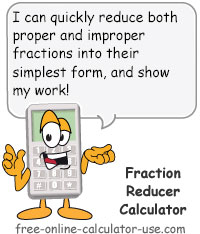IMPORTANT: Numeric entry fields must not contain dollar signs, percent signs, commas, spaces, etc. (only digits 0-9 and decimal points are allowed).
Click the Terms tab above for a more detailed description of each entry.
Step #1:
If you are simplifying a mixed number, enter the whole number portion (e.g., if simplifying 8-2/3, enter the 8 on this line). If not a mixed number, leave this line blank.
Step #2:
Enter the numerator (top) of the fraction to be reduced.
Step #3:
Enter the denominator (bottom) of the fraction to be reduced.
Step #4:
Click the "Reduce Fraction" button, which will display the generate the greatest common factor of the numerator and denominator and the reduced fraction and generate a step-by-step explanation showing how the calculator arrived at the result.



Follow me on any of the social media sites below and be among the first to get a sneak peek at the newest and coolest calculators that are being added or updated each month.